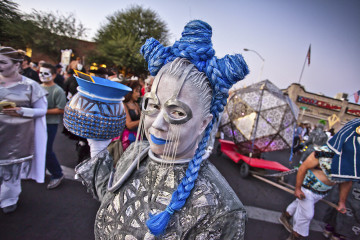
from Wild women shaking the season
by DANYELLE KHMARA, October 29, 2015
The Facilitator
Inside the loading dock and basement of the Funeraria del Angel funeral home on Stone, Melanie Cooley, the volunteer coordinator for Tucson’s All Souls Procession, is spending her afternoon at one of the free All Souls Arts Workshops, which started in September and run until the procession, the weekend of Nov. 7 and 8.
Cooley’s in sweat pants, with her hair pulled back, under a bandana. She’s helping a woman figure out how to transpose images of black and white photos onto a white smock. Children are crafting at a table. A little boy proudly holds up a purple rock he just painted.
The 26th annual All Souls Procession is on Sunday, Nov. 8. People gather at 4 p.m. on the corner of Sixth Avenue and Seventh Street and begin the walk to Mercado San Agustin at 6:30 p.m.
The procession, started by local artists in 1990, now has over 150,000 participants annually. The gathering in downtown Tucson is adorned with costumes, people in face paint, floats and signs with pictures of family and friends who have died. People then parade the two miles to where the finale takes place and the ceremonial burning of the urn, full of all the participants’ prayers and messages.
“There is this spirit of recognition of our shared humanity that we don’t get a lot. And that we’re able, all of us who are there, to see complete strangers and recognize in that person this shared love and this shared grief, and that fundamental experience of being human that we will all mourn or be mourned by everyone we love,” Cooley said. “That we can recognize that in each other is a powerful thing, and it runs deeply counter to the way that our culture functions on a day to day basis.”
People create elaborate packets, which they decorate and prepare to be burned in the urn. It’s not uncommon for people to put in wedding dresses, dried flowers, photographs of loved ones, messages to letting go of a dream that isn’t going to come true, a name of somebody that has died or an actual letter to that person, said Cooley.
She’s been the volunteer coordinator for three years, and it’s a full-time job for the month-and-a-half leading up to the procession.
She’s also on the board for Many Mouths One Stomach, the organizing body for the All Souls Procession, and for seven years she’s been part of the Community Spirit Group, a group of urn escorts during the procession. She’s one of the urn attendants.
“The attendants are very much about being the hands of the urn, a role that’s about being kind of ritually prepared to be a non-person,” said Cooley. “Not an individual, but somebody who is able to be entrusted with all of those messages and those precious remembrances from hundreds and thousands of people over the night, so it’s really about being that physical, embodied extension of the urn.”
This year, she’s focusing on leading the ambassadors—the people that give out paper and pencils during the procession so people can write their messages for the burning of the urn at the end of the evening.
“Putting remembrances into the urn is something we do collectively,” said Cooley. “What that means is really up to everybody who put something in it.”
The theme of this year’s procession is unmournable bodies. She describes the theme as a commemoration to those people that are culturally turned away, forgotten, rejected, and aren’t considered worthy of public mourning.
She explains that can mean a whole range of things—immigrants crossing the desert that have died, prisoners, addicts or enemies killed in battle. One of the angles some of the participants are looking at is veterans that have committed suicide.
“So many times, if somebody is killed in active duty, they’re valorized, but we’ve lost three times as many of our veterans to suicide once they’ve come home, and they are not valorized,” said Cooley. “They become unmournable bodies. They become not recognized. They become difficult for our culture to embrace.”
The urn ambassadors are focusing on the forgotten ghosts of the road, Cooley said. The forgotten people who have built the infrastructure of this country—the slave laborer, the prison laborer, miners, braceros and Chinese railroad workers.
“And really looking into that history of how has our country been built, and who are those people who have done that work, and can we bring their names, if we can find them, their faces, their memories into this and honor them,” Cooley said.
All the work of the procession creates community in a way that we don’t have a lot of in our culture, short of sports and religion, said Cooley.
“Over my adult life, I’ve really worked to find ways to find community and find that kind of community commitment to one another, that sort of energy that church communities traditionally have,” she said.
Cooley grew up in an atheist family in a predominantly Southern Baptist town in Chicago. As a child, she felt cut off from community celebrations and organizations because it was structured around church.
“This community really has that feel, of people that are focused on a common greater good and as a result, will take care of each other, will look out for each other, have a connection to each other even if they’re not intimate friends,” she said.
“And that community crosses cultural and socio-economic and all sorts of traditional barriers. We have everybody from bus drivers to billionaires who are involved in the procession, who are connected to one another through this. So it really has a potential to change our world for the better.”
For more information on the 2015 All Souls Procession or for information on how to get involved in next year’s go to allsoulsprocession.org or All Souls Procession Weekend on Facebook.